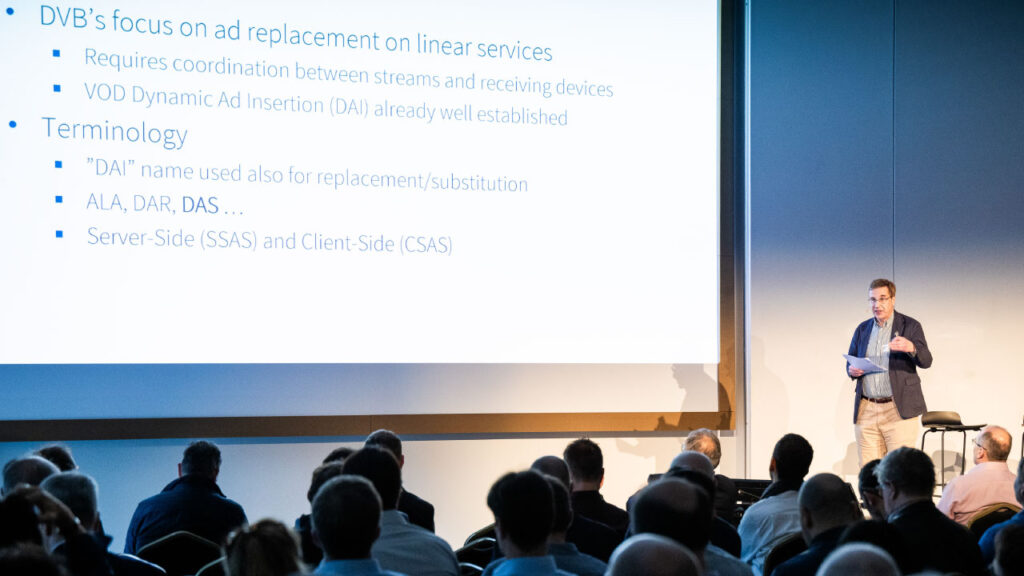Martin Gold (YouView TV Ltd)
DVB’s work on Targeted Advertising (TA)* was very timely relative to YouView’s own interest in the subject. Around the time that DVB commenced its TA activity, YouView had already started to collaborate with ITV and Channel 4, two major advertising-funded UK public service broadcasters, on a system design for TA on linear broadcast channels. Both YouView and ITV contributed to DVB’s TA work.
YouView is a UK-based technology and services provider, specializing in client software and cloud services that power content discovery experiences on a wide range of consumer devices, including those from BT, TalkTalk and Sony. The majority of such devices are hybrid broadcast/IP, supporting linear channels via both DTT and IP multicast.
DVB’s work on TA covers both HbbTV-based and other devices, the latter more prevalent for network operators’ set-top boxes (STBs). In YouView’s case, referring to the DVB-TA reference architecture shown below, the system follows the option for the client’s “Ad Requester” function to be split between a DAS (Dynamic Ad Substitution) app, which is implemented within YouView’s middleware, and a DAS app proxy, which is built as cloud services. This approach has the advantage that the STB DAS functionality is simplified and common across different broadcasters, with the cloud services performing adaptations as needed.

A client device performing ad substitution on a broadcast stream requires precise signalling for the frames at which to start and end the replacement. SCTE 35 is a well- established specification for such signalling, but the specification has many options. DVB-TA profiled SCTE 35 to ease implementation and improve interoperability. To accommodate different client types, DVB-TA supports three different ways of conveying SCTE 35 data. YouView middleware can directly access MPEG-2 Transport Stream sections, so this method was adopted, as it was already supported in broadcast headend equipment.
Timing challenges
A key challenge for TA on broadcast streams is that an individual ad decision (i.e. the selection of the replacement ad) is needed for each device for an ad spot that will occur at the same time across all the devices. Earlier implementations relied on the ad decision being performed in the client. However, server-based decisions, typically using ad responses to the IAB VAST specification, as recommended by DVB-TA, would allow more sophisticated targeting, decisions could be based on the current fulfilment status of ad campaigns, and more complex rules could be supported, such as avoiding competitors’ campaigns being shown in the same ad break.
In the YouView TA implementation, the ad decisions for an ad break are spread over the time between one ad break and the next on a channel, such that the ads shown in one break can influence the decisions for the next break. The timing for the ad decisions is orchestrated by a cloud service that informs each client device when to request the next set of ad decisions. The maximum advance time for the ad decision can be tuned to be closer to the next ad break if the broadcaster’s ad- decision server can handle the increased transaction rate.

Martin Gold gave a presentation on DVB Targeted Advertising at DVB World 2024 in Munich in March 2024. A recording of that presentation is available in our Webinars section.
The DVB-TA specification discusses different approaches according to the timing accuracy of splicing achievable in the client device. For the YouView devices, the accuracy is sufficient that individual ad spots can be replaced in any combination within ad breaks constructed as a sequence of immediately adjacent ads, and so is compatible with existing UK broadcast practice.
After an extended period of trialling, TA on the YouView platform launched in 2023. Since then, the service has been growing steadily, with further channels and device models being added.
* The DVB Targeted Advertising specifications are as follows: DVB-TA Part 1 (broadcast signalling); DVB-TA Part 2 (interfacing and preparation); DVB-TA Part 3(DASH signalling)
Martin Gold is a Principal Architect at YouView TV Ltd. He has been an active contributor to DVB for more than 25 years. He was editor of the DVB-TA signalling specification and led the drafting group for its creation.
This article first appeared in issue 63 of DVB Scene magazine.

